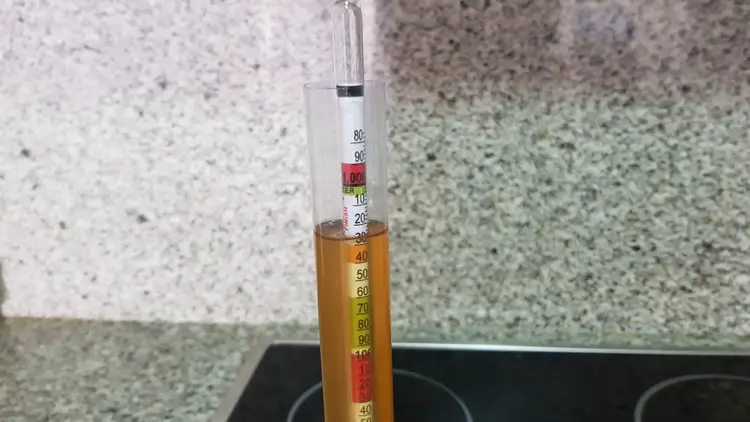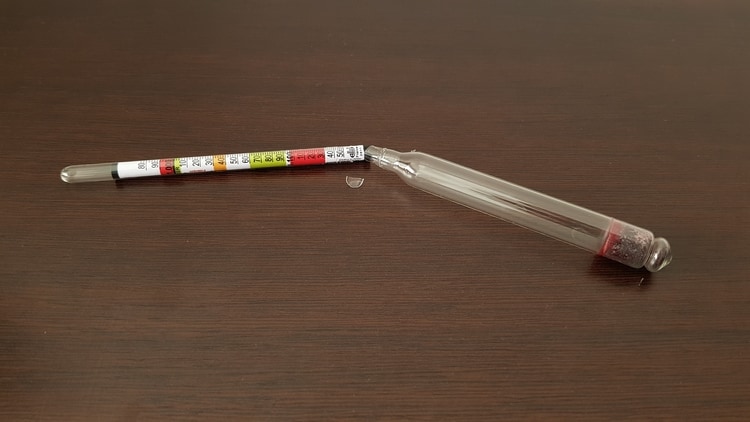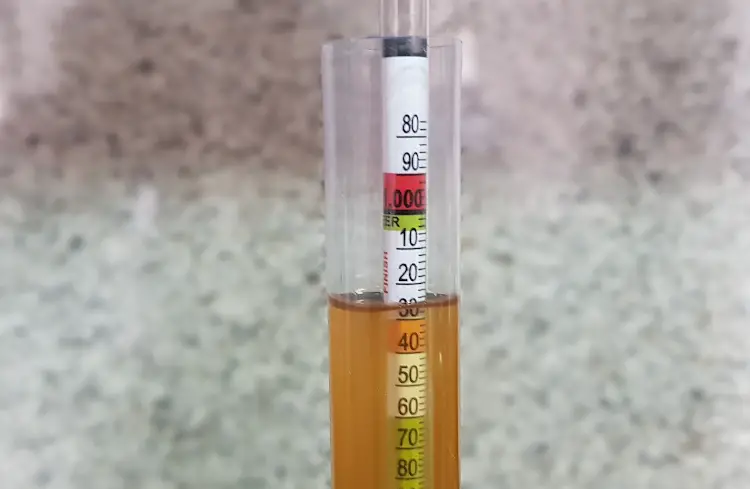How much alcohol does this batch have? This question sticks in the back, or front, of every homebrewer’s mind.
We follow the recipe closely, or not, and go through each step of the process meticulously, or not, and in the end, we enjoy the refreshing goodness of the beer we just made, with care and love, and…
How strong is it? We simply must know!
Measuring alcohol content without Original Gravity (OG) is difficult to do precisely. You can get a very close estimation with experience and some easy calculations. Refer to old recipes. You’ll make a good guess by how much ABV per pound of malt, and degree of attenuation.
What is Original Gravity and is it Easy to Do?
Taking the Original Gravity (determining the sugar content of raw beer) is recommended to each brewer as it compares the sugar content of the before and after product.
As a winemaker takes a few drops of fresh grape-juice off the vine and squeezes it onto his refractometer (a manual light meter that measures sugar and potential alcohol) so the hydrometer (a long glass tube, to float in raw or finished beer) measures sugar and potential ABV for the brewer.

There is alcohol by volume, original gravity, and alcohol by weight, called plato or balling.
For example, you are brewing a Scottish Ale, Malty rich and warm, your original gravity by volume may be 1.080. That is the post-boil weight of the wort (sweet, unfermented beer).
After fermentation, you check again, and being a heavy Scots beer, it may be 1.016.
The proper formula is as follows:

1.05 is the weight of alcohol and .79 is the density. But we need not dwell on this, as… our hydrometer is “broken” and we’re trying to know our alcohol content without O.G.

Method 1 – Sneak a Peek at the Can
Most brewers from their early experiences brew from canned kits, and some of them produce fine beer.
I especially liked John Bull Extra-Light Extract, Unhopped.
It had the lightest color of any can I could find and allowed me to add my own hop profile.
On the can it said, “one can produce an O.G. of 1.032-1.036 in five US/ Imperial gallons.”
One can was 3 lbs.: US/ Imperial weight.
After reviewing some recipes in a brewing book, I knew that was a little light so I used 2 cans. I knew that would give me a beer of roughly 5% alcohol.
Therefore, I knew that one pound of malt would give me .83 % alcohol per pound. Two cans invariably did the trick, still brewing for a five-gallon batch.
You could add a little less to make an English bitter, milder in alcohol- 4%, perhaps some crystal malt and a touch of chocolate malt for color and sweetness.
If you want a stout or porter stronger dark beers- 5-7%, add some roasted malt or chocolate malt for that rich toasted, oven-baked flavor, as well as some oatmeal or flaked barley for mouthfeel. You will get a nice body, and 2-3% more alcohol.
These extra malts, chocolate, roasted and crystal (caramel), will be cracked, steeped and removed before the boil. They add body and flavor, but no alcohol at this stage.
Method 2 – Reference your Body of Work (or Play)
Let us assume you know your way around the brewing kitchen, garage or man-cave pretty well. You have done this before.
Trust yourself and brew by your feeling and your intuition of what the beer needs.
You may refer to your notes from past brews, or recipe sheets if you have them.
Each brewer will have his own methods, some more technical, others carefree to the point where each recipe is a free-for-all and may not even be written down.
I recommend a combination of each, suitable to your temperament and talents.
Look at your old recipes.
In April, you brewed an American Nut Brown Ale, with a pronounced chocolate flavor and a nice hop bite.
Your OG was 1.048, and your FG finished a tad high at 1.012, due to the concentration of dark malts and dextrin malts (for mouthfeel) in the kit.
You did make a small notation on bottling day that the alcohol percentage was about 4.7% based on the simplest equation we had.
You glance at the recipe and used 6 lbs. of malt and you got roughly 4.5%.
There is your benchmark. Tuck it away somewhere in your mind. You will need to come back to it.
Method 3 – Follow your Gut
To some of our detriments, we brew purely from the gut, whim, and mood.
At times this produces quality results in flavor, character and strength.
Be warned! It is often easy to forget what you did right.
Today, this brew day will be a special day.
You will make a high-gravity Belgian Ale.
You still haven’t picked up a new hydrometer.
Never mind, somewhere in your notes, you have that Brown ale recipe, and tucked away, not too far back in your mind, you remember, 6 pounds of malt, 4.5% of alcohol.
Well, that’s good news because today we will make a real butt-kicker of a beer.
A strong Belgian Double Malt, a brown ale with subtle toasted overtones, deep maple-brown color and barely perceptible hopping. Most, if not all of the profiles will be in the malt and defined by the yeast. (Belgian flavor profiles are often defined by their yeast)
You take your 6 pounds of malt as a base and increase your malt bill by three pounds.
This should get you up around 6.7% give or take.
Next, you brought something special, Black Candy sugar. Belgian brewers rarely use highly kilned or toasted malts such as Caramel, Munich or Chocolate malt in high concentrations within the mash (mix of grains used for malt sugar extraction) itself.
They use them rather for color, steeping them in the kettle, pre-boil, exactly as homebrewers do.
Black Candy Sugar is a premium form of rock candy made from beet sugar. The Belgians prefer it for brewing as it has a cleaner profile than sucrose or dextrose, both of which can add an apple cidery flavor.
Add one pound of sugar and you may get .75% added to the mix.
So, your hearty, warming Belgian Double Malt finishes at about 7.5%.
Who needs a hydrometer anyway, I got this one down!
Method 4 – A Little Inductive Logic
You didn’t break your hydrometer after all, you just forgot to get a reading before you pitched and started cleaning up.
Also, it was a new recipe with new malts, new hops, and a new style of beer. Well, there is still one rabbit you can pull out of your hat, and complete your recipe down to exacting detail.
Working Backwards
After your fermentation and conditioning are complete (a 2-3 week process), you are ready to bottle. The first thing you do, before filling the first bottle is to fill your hydrometer flask.
The main reason is to taste your beer and see how it came out. Have confidence, it will turn out well.
Secondly, take a Final Gravity reading. Suppose your final gravity came in at about 1.012. As a beginner brewer, and even advanced, you will have an idea of your attenuation rate (the percentage of sugar converted to alcohol).
It is likely 75-80%, meaning that 20-25% of your sugar and other proteins remain in the beer. They give it flavor and mouthfeel.
In this case, you can extrapolate that 1.012 is about 25% of the original gravity.
Multiply .012 x 4 = .048. Your original gravity was 1.048. You initially subtracted 1, as it is the base weight of water, then add it back for the final reading.
Get the feel for what you are doing
Create a flow and comfortable space to make your beer, if not physical space then mental space.
Play music you love, drink your favorite beer, your own if you have it, and enjoy the process.
With a good recipe in hand, you will find your way, your method and your comfort zone to create the flavor and experience you want.
When friends come over, they will be excited to try it, unlike the first few times, when you had that nice black-olive nose, or it shot out of the bottle and hit the ceiling because it was still fermenting in the bottle. You and they will look forward to the new flavors regularly emerging from your kitchen.
The loveliest words a brewer can hear, with humility, is when a friend tells you, “This is really nice beer, I couldn’t even tell it was made at home.”
You smile, say thank you, and clink your bottles together. Then they ask, “What’s the alcohol content of this one?”
You think a minute, what recipe was it, how much malt? “Oh, about 6.5-7%, something like that.”
“Wow, strong,” they reply, “but I can hardly tell.”
Can’t wait to make the next batch.

